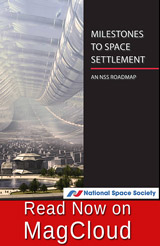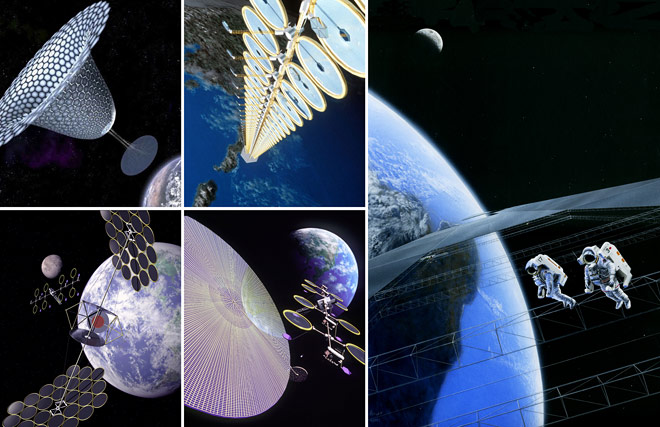
- Part I: Introduction
- Part II: Milestones to All Destinations
- Part III: Utilization of Space Technology and Resources (this page)
- Part IV: To the Moon
- Part V: To Mars
- Part VI: To the Asteroids
- Part VII: To Orbital Space Settlements
- Part VIII: To the Stars
- Outline of the Roadmap
- PDF version of entire Roadmap (6 MB)
- Order full color print version
Part III: Utilization of Space Technology and Resources

Space Solar Power Concepts [credits]
MILESTONE 7: Applications of Space Technology on and for Earth.
The technologies and techniques developed on the road to space settlement applied widely and benefiting all on Earth.
The technologies and techniques developed for space settlement will not be limited to space settlements. Rather, as has always been the case, both directly and indirectly they will provide widespread benefits to Earth economies and lifestyles, as well as providing humans with a substantially enhanced ability to protect this planet from the impacts of comets and asteroids.
Some benefits will be realized almost immediately. Others will materialize over longer periods of time.
In General: Direct Benefits
Anticipated benefits from that continued investment in space activities include
- Satellites for Communication. As space platforms increase in size, power, capability and numbers, existing public and private applications (such as direct-to-user-from-orbit TV, radio and data) will be augmented by more and increasingly sophisticated communications services.
- Satellites for Global Positioning, Navigation and Timing. The establishment of such resources in space has already revolutionized life on Earth, as entire economies have begun to blossom around location-based services; these uses will proliferate.
- Satellites for Remote Sensing. Improved use of space-borne sensors, in orbit or on the Moon, will increasingly be used for such purposes as: better weather monitoring and prediction; location of buried mineral deposits; keeping abreast of crop, fresh water and sea conditions; understanding geological conditions; and, eventually, detecting imminent earthquakes.
- Commercial Use of the Space Environment. New products and knowledge will come from orbital research and manufacturing facilities utilizing the vacuum and weightlessness available only in space.
- Biomedical Knowledge from the Space Environment. Observations and experiments in weightlessness have provided crucial medical insights and breakthroughs, as well as revolutions in medical monitoring. Continued breakthroughs are to be expected, especially with respect to the conditions of human aging.
- Ecology. People living in space and on other worlds will need to conserve and recycle resources to a greater extent than we do on Earth. The technologies and system improvements developed should have widespread applicability to living on Earth.
In General: Indirect Benefits
What is designed for space application will challenge and inspire thousands of young minds and will find thousands of new applications on Earth. That has always been the case with the investment in space. After building spacecraft, scientists and engineers looked at the thousands of specialized small parts they created, that would not have existed but for the focused goal of space exploration (and the need to preserve priceless human cargo), and then found new on-Earth uses for them. In that process they created dozens of new industries and thousands of new jobs on Earth. Those benefits were in addition to benefits in the space industry itself and in addition to the ordinary multiplied effects of any government or industry spending. Similar benefits will continue to arise from future space development.
Later: Extra-Terrestrial Raw Materials
The Moon and the asteroids contain metals and other materials that are rare on Earth, e.g. platinum. As space technologies are developed and the human presence increases beyond Earth orbit, transportation costs will come down and allow the harvesting of these resources and their return to Earth, or their use in space.
Later: Sunlight from Orbit
As orbital infrastructures become more sophisticated, new capabilities may emerge, including the ability to use giant space mirrors to modify the Earth’s weather, for example, to increase the food supply (by increasing growing hours) or fresh water (by influencing rainfall patterns) or to provide illumination in dark areas. While world cooperation and unintended consequences will be significant barriers to such uses, the technology should be feasible.
Further Reading
- How Space Can Improve Life on Earth [PDF]
- Potentially “Revolutionary” Space Applications [PDF slides 3.5 MB]
MILESTONE 8: Space Solar Power System (SSP).
Establishment of an operational space-based solar power system transmitting the Sun’s energy to Earth.
Space solar power can potentially supply all the electrical needs of our planet. SSP will transmit from orbit energy from the Sun that is clean and reliable and, most significantly, inexhaustible.
Many of the world’s greatest problems will be greatly alleviated by accessible energy or cheap energy, or both, which can be provided by SSP. For example, SSP can provide energy to replace fossil fuels, energy to light and heat homes and factories in remote areas, energy for farming, energy for transportation, and energy to desalinate sea water.
SSP can reduce or eliminate the need to burn fossil and nuclear fuels to generate electricity. This use alone currently represents about one-third of all the world’s energy demands. The capacity of SSP is so large that it should have an immense effect in reducing production of greenhouse gasses and their effect on global climate.
As the initial system is augmented and improved, increasing percentages of terrestrial power needs will be supplied from space. Even before the system is completed, the realization of the pending availability of so much energy could promote world peace by substantially reducing the need for nations to fight for control of fossil fuels.
Most of the system will provide continuous base load power, notwithstanding night or weather conditions, but some of it can be for intermittent or emergency use. With an ability to be directed to multiple locations, even isolated settlements, SSP increasingly will obviate the need for expensive, delicate, and politically sensitive long-distance re-transmission networks between power plants and all the places of end use.
The scientific feasibility of SSP has been established, and the search is underway for a consensus as to the best designs and needed infrastructure.
Further Reading
MILESTONE 9: A Workable Asteroid Protection System.
A system capable of detecting and defending against Earth-approaching asteroids or comets built and standing by to launch on short notice.
It is widely recognized that the extinction of the dinosaurs was largely a result of an asteroid smashing into the Earth. That such impacts can still occur was demonstrated by the cataclysmic impacts of Comet Shoemaker-Levy 9 fragments on Jupiter in 1994 which were witnessed by hundreds of millions around the world. Dinosaurs could do nothing to protect themselves; humans can.
In time, just as their citizens buy home fire insurance that almost never will be used, governments will come together to create the capability to better detect threatened collisions and then design and build a defense against them.
As to detection, telescope sky scans have located and calculated the orbits of thousands of asteroids and comets, but so far have identified none likely to be large enough or close enough to dramatically impact Earth. However, large parts of the sky, especially outside the ecliptic, remain unsearched and our telescopes are still not sensitive enough to identify smaller but still dangerous objects. Every year large objects pass Earth just inside or outside the orbit of the Moon without being discovered until very close or even until after they passed.
As to defense, the scientific know-how exists to divert smaller asteroids still far from Earth. However, adequate knowledge of the composition and internal structure of the larger objects is still lacking. Consequently, the knowledge about the best way to deflect or destroy them is likewise lacking. Future missions to asteroids and comets should help fill in that knowledge gap. With that information, whatever launch systems, weapons systems and in-space infrastructures are necessary to protect the Earth can and will be built, and will remain on standby for launch on short notice against a threatening celestial object that is late being discovered.
Reduction of launch costs from other space activities would make their creation more feasible and attractive to governments, and therefore more likely to be achieved sooner. And, if the world should see a need for urgency in creating such a defense system, that priority could itself be a driver for the higher launch rates and accompanying reductions in launch costs that would spur realization of other space benefits.
Further Reading






